Star Trek: What Are The Limitations Of Replicator Technology?

Your changes have been saved
Email Is sent
Please verify your email address.
You’ve reached your account maximum for followed topics.

The Legend of Zelda Movie Needs To Get One Big Thing Right
Scream 7: kevin williamson's original scream 3 plans would make for a perfect sequel, instagram unveils two new lightsabers from star wars: the acolyte.
Out of all the amazing, influential technologies present within the Star Trek franchise, one of the most impressive is the replicators . Their ability to conjure almost anything with a simple command has the possibility to end world hunger in the blink of an eye. It can create any tool needed for any task without having to rummage around in endless toolboxes. They can even create material possessions such as clothing or furniture.
However, every piece of technology, no matter how remarkabe, has its constraints. While they may appear limitless, there are in fact a number of things that a replicator can not do. These are the biggest limitations of replicator technology, as shown in the Star Trek shows and movies.
RELATED: Star Trek: Exploring Klingon’s Unique Warp Technology
The first is their inability to create Dilithium crystals, the necessary ingredient for all warp travel in the galaxy ( especially if abiding by what Discovery preaches ). Replicating Dilithium goes against the fundamentals of how this technology works. A replicator does not simply magic up the things it produces. Rather, it takes energy and reconfigures it on a cellular level into whatever is requested. Different things take different amounts of energy based on their complexity. An apple, for example, is fairly simple on an atomic level. Meanwhile, a gold necklace is far more complicated, requiring not just a reconfiguration of atoms but various forms of fusion to combine them. Replicators can create a lot of difficult things, but Dilithium is so complex that there would not be enough power to create it.
The exception might be the use of Dilithium itself to create Dilithium, directly plugging the replicator into the warp core power. However, it is established that replicators still abide by the second law of thermodynamics: As energy is transferred, some will always be wasted. As such, energy will always be lost in the process of replication, no matter how much power is pumped in. This means that even if there was a way to use Dilithium to replicate more Dilithium, the user would end up getting far less than was used up in the process. Attempting to replicate Dilithum would be a waste of time.
This leads on to the second limitation for replicators: that of sustainable food sources. It’s true that the use of these nifty machines would easily eradicate world hunger , but not Quadrant-wide hunger. The Federation still relies on naturally grown food to support its massive population. The amount of energy required to produce ample food for everyone would be far too much to sustainably support. It could be possible, via growing something in abundance, converting that into energy, and using said energy to power replicators en-mass. However, it's much less practical when there are hundreds of vegetation-supporting planets all primed to be able to grow food. On a side note, though, replicators are still great for vegans and vegetarians in this regard. The technology can replicate animal products without ethical issue, converting vegetation into replicated meat.
The next limitation is that a replicator, despite appearances, can only create inanimate matter. There is no way one could be used to create life. Now, life is an interesting topic in this regard, as it is specifically different from organic matter. A vegetable is different from a living, breathing being. The difference is that inanimate things can be replicated by using cellular and molecular reconstruction, taking energy and reassembling it to appear similar, if not identical, to the real thing. What they struggle to do, however, is anything on the quantum level. This is necessary for things relying on neural patterns or pathways to function and ‘live.’ While this is impossible for the majority of replicators, it’s not actually unfeasible. The biggest issue is that of storage potential. Most things take up little to no memory to replicate, their patterns being relatively simple. However, to replicate anything on the quantum level would be so complex that there wouldn’t be enough storage to contain that much information.
It’s not impossible, however, and already these devices started to sneak into canon. TNG featured a special replicator that was able to create and replace Worf's spine ’s spine after a terrible accident. However, this is where the technology seems to have reached its current limit, as it cannot create functional body parts yet. If they struggle to do, this it’s no wonder that the idea of creating sentient life is deep into the realms of impossibility, even with the technology available to those in the 24th and onward centuries. Even without the use of replicators, sentience and ‘life’ is hard to create. Characters such as Data and his evil twin Lore are unique.
Replicators seem to present a duality within the Star Trek universe. On one hand, they are a prime example of possible future technologies. Yet at the same time, they show that there are still massive limitations even to such advanced minds found within the Federation. Even in the far future, there are still some things humanity cannot yet do.
MORE: Star Trek: Why Ezri Dax Was So Unpopular
The Nuclear Mutant Trope In Sci-Fi, Explained
Game rant's ultimate sci-fi guide, every live action series on paramount plus, ranked.
- Movies & TV
- GR Originals
Star Trek: How Do Replicators Actually Work?
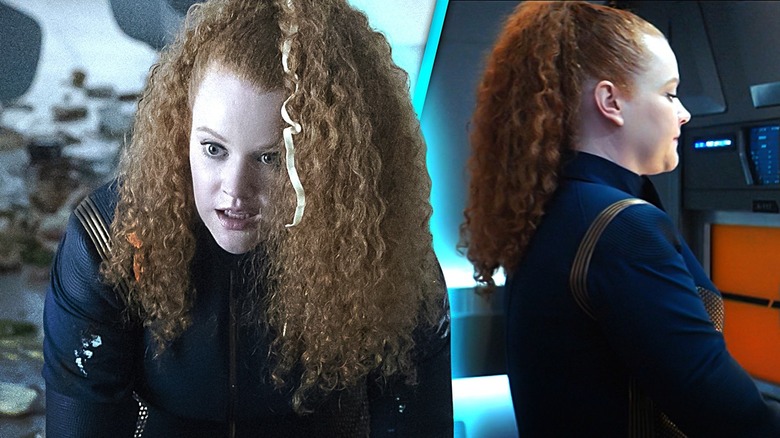
When we think of obstacles to interstellar or even just interplanetary travel, problems like fuel and cryosleep immediately come to mind. But one of the most significant problems humanity must overcome is how to provide nutrition for an entire crew during the months, years, or decades spent with nary a soil sample in sight. In the world of "Star Trek," there's a simple solution for feeding a ship's crew: replicators. Contrasted with today's world where most people toil away endlessly to keep up with the ever-inflating costs of food, clothing, and housing, the replicator represents the mark of a post-scarcity era, freeing humanity to focus on exploration and the pursuit of knowledge and the arts. The future's answer to microwave ovens, replicators are small enough to be installed in every room and accessible enough that a child can use them. Crucially, they are capable of creating just about anything a Starfleet officer could want (just as long as Starfleet's safety protocols and regulations allow for it). By the 24th century, replicators have become so ubiquitous that cooking has become more of a hobby or art form than a necessary life skill.
The ultimate recycling machine, replicators are the evolutionary successor of the protein resequencer technology seen in "Star Trek: Enterprise." Using transporter technology, they work by completely deconstructing matter and then reconstituting it into a desired product. But unlike Starfleet's existentially frightening transporters, which rely on molecular imaging scanners, replicators use a quantum geometry transformational matrix field to fill an order based on a stored pattern matrix — which is why if the ship can only create things it has a recipe for.
Replicators evolved from protein resequencers
When Starfleet first takes to the stars with the NX-01, they haven't yet developed replicator technology, instead relying on a combination of food from their hydroponic greenhouse, resupplied galley food, and food generated from the protein resequencer. Exactly how fundamentally world-changing replicator technology is to the world of "Star Trek" is driven home in the "Star Trek: Enterprise" episode "Dead Stop." While checking out an automated station, the crew encounters what T'Pol (Jolene Blalock) calls a "molecular synthesizer" similar to one she'd seen aboard a Tarkalian vessel, describing the device as "similar to a protein resequencer but far more advanced" and "capable of replicating almost any inanimate object."
After Trip Tucker (Connor Trinneer) orders a pan-fried catfish, T'Pol surmises that the technology must have scanned the Enterprise database to access a recipe stored in Enterprise's computer along with a copy of the catfish genome. Trip immediately observes that such a technology would revolutionize parts fabrication for the engineering department.
By the time of "Star Trek: The Original Series," the technology has advanced quite a bit, even if has not yet attained the standards Picard's crew will one day enjoy. How far they still have to go is referenced in "Charlie X" when Kirk (William Shatner) comments that he wants the crew's synthetic meatloaf to at least appear like turkey for their Thanksgiving celebration. Sometimes referred to as food synthesizers, these earlier models of replicator technology worked by using diet cards or tapes like those demonstrated by Nurse Chapel (Majel Barrett) in the "TOS" episode "And the Children Shall Lead."
Replicator food is recycled poop
Just like today's astronauts recycle their urine, Starfleet saves space by recycling other types of matter, even the kind we don't like to think about. Responding to a "poop question" from a curious group of schoolchildren in "Breaking the Ice," Chief Engineer Trip Tucker explains that like just about everything else aboard their starship, human waste is recycled in the biomatter resequencer. "The waste is broken down into little molecules and then they get transformed into any number of things we can use on the ship — cargo containers, insulation, boots — you name it," Trip specifies.
While the resequencers would eventually be replaced by replicators, the basic principle behind the technology remains the same a millennium later in the 32nd century, as emphasized by Fleet Admiral Charles Vance (Oded Fehr) in the "Star Trek: Discovery" episode "There is a Tide..." to Osyraa (Janet Kidder). After revealing that he had never eaten a real apple, Vance tells the Emerald Chain representative, "It's made of our sh**, you know. That's the base material that we use in our replicators. We deconstruct it to the atomic level and then reform the atoms." And although some audience members might find this "Star Trek" revelation somewhat horrifying, Vance is quick to add that all things considered, their reconstructed waste actually tastes "pretty good."
The mechanisms behind the replicator waste recycling system is further outlined in the "Star Trek: The Next Generation Technical Manual," which explains how the ship directly recycles anything it can. Anything that cannot be directly recycled gets broken down first including waste. As Michael Eddington (Ken Marshall) tells Benjamin Sisko (Avery Brooks) in "Star Trek: Deep Space Nine," they both know they're really eating replicated protein molecules and textured carbohydrates ("Blaze of Glory").
How Are The Replicators Supposed To Work On Star Trek?

Coffee, black, or Earl Grey, hot? If you're a "Star Trek" fan, you've probably heard a character or two say these words. You might think of Captain Kathryn Janeway of "Star Trek: Voyager" and Captain Jean-Luc Picard from "Star Trek: The Next Generation" and "Picard" are just big breakfast drink fans, and they are, but they're also busy leaders of working space starships. They needed a way to get their favored drinks fast. So they turn to their replicators.
Replicators are essential machines in the "Star Trek" universe. This device can reproduce food, tools, and sometimes even random viruses. Depending on the writer's imagination, it can make almost anything. In times of need, the replicator is the only thing that can feed the crew. And being so far from Federation ports and basses, replicators were their best bet in getting that one part they need to fix their warp core containment.
While the replicator has made many appearances on the shows — Janeway even took hers apart in one episode — it's remains a tool of mystery to many. It acts a lot like a transporter, because it kind of beams food. So how are these things imagined to work in the first place? Of course, this is a starship, and the explanation is very sci-fi.
It's kinda gross, really
According to the "Star Trek" website , the reason some people see replicators as mini-transporters is because, well, it technically is one. In "Star Trek," transporters "beam" people and items to different places. They dematerialize matter and reconstitute it somewhere else. The replicator essentially acts the same way. So what matter does it work with? Comic Book reported the not exactly appetizing news. An episode of "Star Trek: Discovery" explained the material comes from fecal matter.
Replicators cannot make new matter because physics simply doesn't allow for that. In the "Trek" universe, scientists had developed a mixture of different materials specifically for food replicators, but it was a finite resource. And so the resource-poor Federation of Planets used something humanity never runs out of: Its own waste. The episode suggests that this sacrifice doesn't come at a human cost, which means the Federation can still claim the moral high ground against their enemies.
Replicators have been in use since the 24th century in the "Trek" universe , though very little has changed around the technology. No matter how advanced, a replicator will only make food programmed into its system. Even so, it beats having to sacrifice a lot of cargo space just to bring thousands of boxes of popcorn. Replicated food will taste mostly the same as the food it mimicked and will also have the same nutritional density. However, that has never stopped intrepid starship captains from bringing the real thing.
Real-life version
Having a replicator certainly means an ability to reproduce just about anything you can think of, provided it's programmed into the machine. So it's very easy to fall into the trap of featuring it in every episode. Bleeding Cool wrote that "Star Trek" writer and producer Ron D. Moore hated the replicator, and so did most people in the writer's room.
Moore said the replicators made everything too easy. If they were stuck somewhere, a character could just replicate something to get them out of a jam. So the writers sometimes avoided using replicators altogether in their episodes.
Fine, in a narrative sense, replicators may make things too easy. But imagine if there was a real-life replicator available. Then, we'd maybe get rid of food deserts once and for all. Fortunately for us, scientists have been working on recreating replicator technology. Per SyFy , researchers at the University of California, Berkeley invented a machine that projects light onto resin to produce an object in minutes. It doesn't re-materialize matter from subatomic particles, but it sure beats waiting hours watching a 3D printer squeeze out plastic.
The technology is based on computed technology, the kind of thing used in medical 3D imaging. The scientists call their new process computed axial lithography. It's not yet fully commercially available, so until then, we're stuck watching our favorite characters eat food replicated from poop.
In Star Trek, You Eat Your Own Poop: Or, Replicators Explained
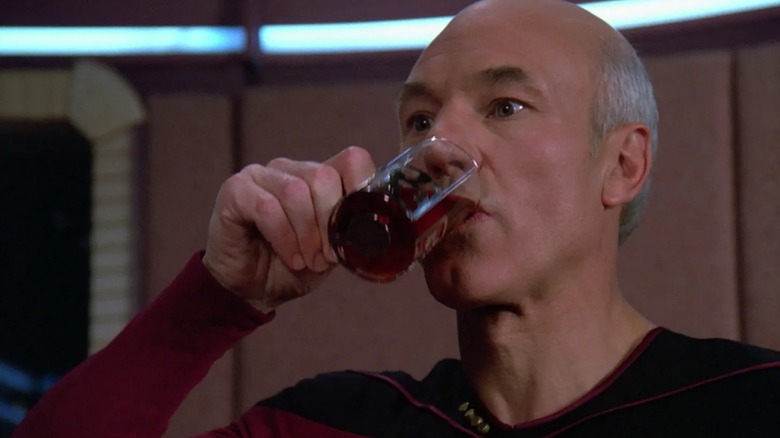
It took a long time for the writers of "Star Trek" to codify the technology on screen, so food replicators have been known by many names over the years. Sometimes it was called a molecular synthesizer, or a food synthesizer. Sometimes it would merely be referred to as a "food slot," which sounds less like a marvel of technology and more like an old-timey coin-operated automat . By the days of "Star Trek: The Next Generation," however, the name "replicator" finally stuck, and viewers could rest assured that a starship populated by over a thousand people has efficient means of feeding its denizens.
On-screen, replicators are perhaps one of the more magical technologies in "Star Trek." Replicators are small alcoves on the wall, equipped with a giant computer, usually located inside crew quarters. A crew member can walk up to the alcove, speak the name of a food or a beverage, and said object will instantaneously materialize. Provided the food or drink in question is programmed into the ship's database, anyone can have whatever meal they want at any time. Hunger is a thing of the past. All the replicator needs is information about cells and proteins, and the raw energy to make something. Captain Picard (Patrick Stewart) regularly ordered cups of Earl Grey tea during his shifts.
It turns out, though, that Picard might technically be drinking his own bodily waste. The dark secret of replicators is that they convert energy into matter, very much the same way the Enterprise's transporters do. That means, of course, that spare matter needs to be transformed into energy first. And where do you think that matter comes from? Longtime "Star Trek" technical advisor Michael Okuda confirmed that at least some of the replicators' energy store comes from matter salvaged from the ship's toilets.
The ship's galley
Of course, replicators weren't standard equipment on "Star Trek" until the days of "Next Generation." Prior to that, Federation starships seemed to have a few replicators that provided a few meals here and there, but most foods were still prepared in a galley, largely kept off-screen until "Star Trek VI: The Undiscovered Country." In that film, several senior officers had a conversation in the Enterprise's galley, and one of them even vaporized a steel cooking pot with a phaser. Comedically, the gluey porridge-like substance inside the pot was not vaporized and even kept its shape.
In the original series, however, it was always a little canonically hazy as to how widespread the replicator technology was. Generally accepted among Trekkies — but not necessarily canonical — is that chefs on the Enterprise could replicate small dishes or specific ingredients, but tended to use ingredients stored in an outsize pantry. If the Enterprise seems large, consider how much of its volume may be stocked with provisions. Doubtless, every space-saving measure is in play, but still, that's a lot of food. The original Enterprise's complement was over 400.
Replicators weren't yet invented in the days of "Star Trek: Enterprise," as that show saw humans encountering the technology for the first time. There was also a lot of talk on "Enterprise" about a character called Cookie, the show's unseen galley chef. Cookie would eventually be play-acted by Commander Riker (Jonathan Frakes) on the holodeck, and the character became strangely important in the show's final episode. Given the limitations of technology, one can imagine that the food on "Enterprise" wasn't very good. Luckily, Cookie only had to cook for 83 people.
But, yeah, you eat your poop
In the pages of the invaluable "Star Trek: The Next Generation Technical Manual," co-author Okuda noted how the Enterprise's replicators are tied directly into the ship's sewage system. Toilets aren't really seen much on "Star Trek," but Trekkies who have ogled blueprints all know where they are located. Okuda wrote that the crew's organic waste is "pumped to treatment and recycling units located in the environmental support complexes on Decks 6, 13, and 24." Via the ship's filtration process, "resulting water is superheated to 150°C for biological sterilization." Once sterilized, the urine is "returned to one of several freshwater storage tanks for reuse." Yes, there is a store of fresh water on the Enterprise-D. Yes, it's made from pee.
As for the solid waste — or, in Okuda's words, "various waste sludges" — it is "electrolytically reprocessed into an organic particulate suspension that serves as the raw material for the food synthesizer systems." Then all of the "remaining byproducts are conveyed to the solid waste processing system for matter replication recycling." Matter replication recycling. They recycle poop into food.
Yes, it's mere energy by the time it makes its way to the replicator's energy systems, and naturally, the bacteria have all been removed, but the people on "Star Trek" are such efficient recyclers that they do indeed eat their own poop. Also, all their other trash. All waste matter — old clothes, dated tech, or mere trinkets you don't want anymore — can be placed on a replicator and de-materialized back into energy at a moment's notice. It's then reused to make new foods and objects. However, the dematerialization process wouldn't be demonstrated on-screen until an episode of "Star Trek: Voyager."
The limits of replicators
Of course, "Star Trek" technology requires limitations, otherwise a lot of dramatic tension would be broken. It's been implied many times over various Trek series that replicators require a lot of energy to operate. Hence, a prankster can't program a replicator to keep making food until the ship's hallways fill with SpaghettiOs and the hull begins to buckle. This notion was reinforced by the events of "Star Trek: Voyager," which saw its title ship stranded 70 years from home. To save energy, replicator access was rationed, a hydroponics bay was erected, and a galley was built. The ship needed a sustainable food source, and replicators weren't it. This became an issue when Captain Janeway's beloved coffee beans were nowhere to be found.
It's also repeated throughout Trek that replicated food ... isn't that good. Several characters note that they can taste when food is synthesized, leading to many amateur chefs trying their hand at cooking in their quarters. It seems some galley equipment is always on hand, just in case. Replicators, though, seem to leave little room for culinary alteration of its programs.
As previously noted in the pages of /Film, alcohol cannot be produced by a replicator. Ancillary technical manuals also explain that poisons can't be replicated. Although whether or not benign ingredients for one species may be poisonous to another hasn't yet been addressed in canon. Perhaps the replicators make foods that are acceptable to every digestive system on the ship.
Replicators are also only capable of replicating smaller objects. No one on "Star Trek" has ever been seen replicating anything larger than a coffee table book. One cannot replicate, for instance, an entire starship.
Of course, if you can replicate a starship, you'd likely be so powerful that you wouldn't need to.
- More to Explore
- Series & Movies
Published Mar 23, 2013
Trek Class Blog: Inventing The Replicator

Inventing the Replicator by Professor Anthony Rotolo
Star Trek ’s replicator is an amazing technology concept that has fascinated us for decades. Working at the molecular level to synthesize materials, the replicator is able to instantly produce nearly any object, food or medicine on demand. It is easy to imagine how the replicator would quickly change the world. Such a device could dramatically reduce or even eliminate the cost of most products. Hunger and poverty would be stamped out worldwide, and much of the time and energy spent working for a living could be used instead for pursuits of education, exploration and the advancement of society.

Star Trek envisions the future of humanity to be one of incredible achievements made possible by evolved philosophies as well as technologies. This hopeful view of tomorrow is perhaps the reason so many have dreamed of inventing real-life versions of Star Trek tech -- from the transporter to the tricorder -- and the replicator is one of the most coveted.From a scientific perspective, aspects of the replicator are theoretically uncertain. Researchers have made slow progress working in this area, but a true breakthrough on the scale of a Star Trek replicator seems centuries away. The day when we will prepare dinner or produce complex equipment at the push of a button (or with a voice command) could be as far away as our own 24th Century.
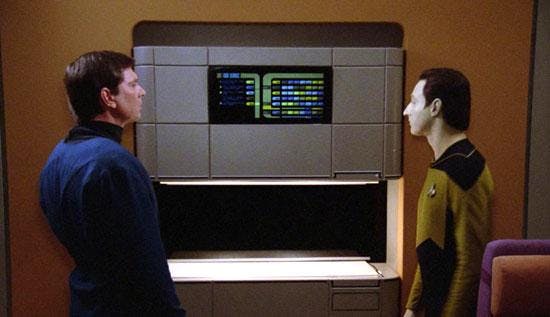
Even if the full vision of the replicator remains beyond our capabilities, perhaps some version of this technology is possible today. After all, the real appeal of the replicator is not in its molecule-synthesizing abilities, but in the value of instant, custom objects made on demand. This is a reality that some are working toward right now using new technologies that could eventually bring us much closer to making the replicator a reality.A process called “additive manufacturing,” or its more popular nickname, “3D Printing,” has captured the imagination of the tech industry. These machines work much like the two-dimensional printer you may have on your desk, but instead of printing a layer of ink, a 3D printer extrudes many layers of melted plastic to form a physical object. You can imagine this as similar to a hot glue gun, where the heated glue stick is carefully extruded from a nozzle. In the case of a 3D printer, that nozzle is controlled by software and digital design files that tells it how to form a shape.
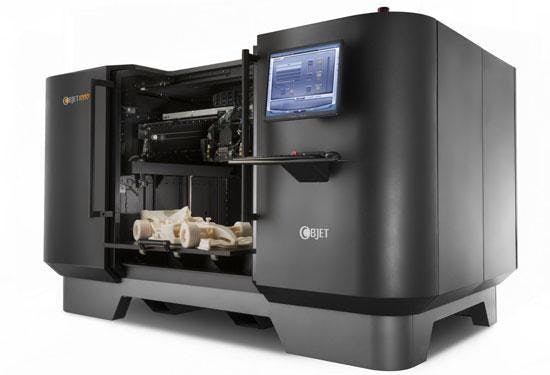
Some have compared 3D printers to modern-day replicators, and it’s easy to see how. Watching one in action is a wondrous experience, with objects that once had to be produced on a factory line fabricated in minutes by a machine not much larger than a microwave. Even complex objects with moving parts can be designed and created one-by-one with a little knowhow. It hardly seems like a coincidence that one of the more popular 3D printer models currently available is actually named the Replicator.The comparisons between 3D Printing and the Star Trek replicator don’t end with plastic. Other materials like wood, metal and even some foods are now being extruded in similar ways to make on-demand creations. This has led to excited speculation that soon we may see the beginnings of a new era of manufacturing in America and around the world, where small-scale production is possible at very low costs. We may even “print” biotechnologies and human organs one day.
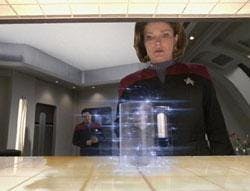
______________Anthony Rotolo is a professor at Syracuse University where he teaches “Trek Class.” He is also the founder and “Captain” of the “Starship NEXIS,” a lab that explores new and emerging technologies.
Get Updates By Email
It’s a wonderful world — and universe — out there.
Come explore with us!
Science News Explores
Could star trek replicators exist.
Experts break down what’s possible and what’s not for this sci-fi invention
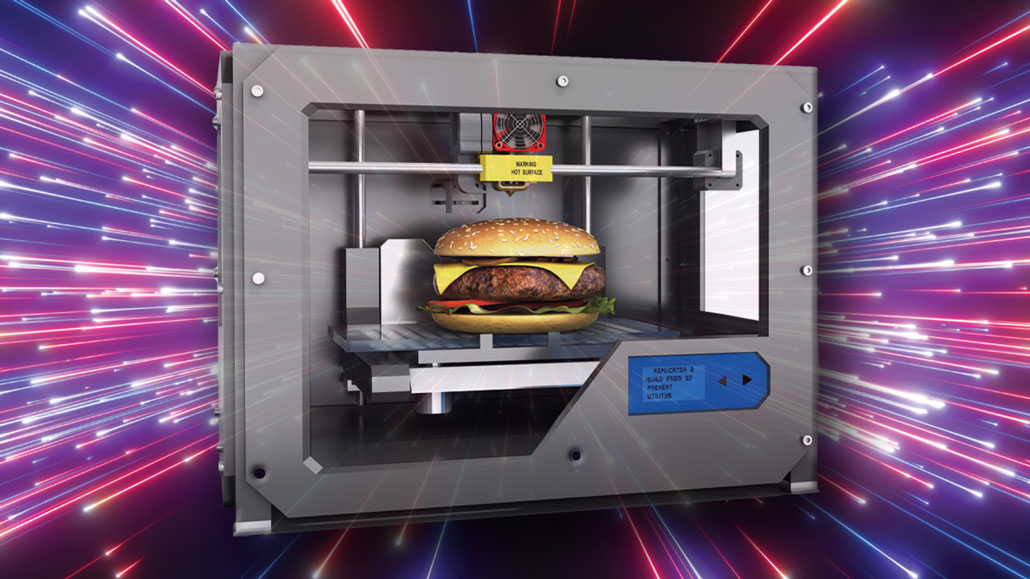
It’s not quite a replicator, but maybe future space travelers will be able to 3-D print dinner on demand.
REPLICATOR: WACOMKA/SHUTTERSTOCK; BACKGROUND: NOSOROGUA/SHUTTERSTOCK
Share this:
- Google Classroom
By Deborah Balthazar
September 5, 2023 at 6:30 am
Let’s say you’re hungry. Wouldn’t it be great to walk up to an appliance, tell it what food you want and have that food appear magically in front of your eyes? In the TV franchise Star Trek , this is possible with a piece of technology known as a “replicator.” Getting to a future where this tech exists, though, might take a bit of imagination and invention.
The Star Trek replicator is used to make all kinds of objects, from a hot cup of Earl Grey tea to spare parts for spaceships. Biowaste and other recycled material is broken down into basic parts: water, carbon and other molecules , explains Erin Macdonald. She’s an astrophysicist and science advisor for the Star Trek franchise. Those molecules are then fed into the replicator. When a person asks for an item, lasers reassemble the bits according to a recipe in the computer until it looks like that cup of tea, a dish of mint-chocolate-chip ice cream or a piece of a warp coil.
What, exactly, is the biowaste that goes into the machine? It will probably include poop, says Macdonald. “We don’t want to think about that too much.”
Educators and Parents, Sign Up for The Cheat Sheet
Weekly updates to help you use Science News Explores in the learning environment
Thank you for signing up!
There was a problem signing you up.
The replicator’s superfast lasers convert incoming matter into energy. Then, they change it back into matter . “On a fundamental level, there is nothing that prevents you from building a replicator-like machine,” says Gianluca Sarri. He’s a quantum physicist who works with lasers at Queen’s University Belfast in the United Kingdom.
But a replicator is just not a top priority at the moment, he says. All that conversion of matter to energy back to matter again would require a lot of energy. Plus, there’s no way to currently make an object appear within seconds. What’s more: Right now food can be generated in a much simpler way — by cooking.
Let’s print a meal
For now, astronauts eat food sent up from Earth. To make sure they get the food they need, future space tourists and crews might rely on hydroponics — growing plants without soil. Cooking that food in space like you do at home might be an option. But it might not always be practical inside the tight fit of a spaceship. So spacefarers might instead print that meal with a 3-D printer.
Today’s 3-D printers are similar to regular printers, notes Jonathan Blutinger. Just as normal printers must be fed cartridges of ink, 3-D printers must be fed cartridges of printing material. Blutinger is a design engineer.
While at the Creative Machines Lab at Columbia University in New York City, he helped create a 3-D printer that acts like a digital chef. “The printer will not allow you to make something from nothing,” he says. “You need to start with the right base ingredients.”
Blutinger’s group recently started with ingredients for a “cake.” They put graham-cracker paste, strawberry jam, peanut butter, Nutella, cherry drizzle, banana puree and frosting into the food printer. The printer assembled and cooked the ingredients with lasers to make a slice of cake.
The cake tasted great, Blutinger says, but it was definitely a unique experience because the flavors came in “waves.” The group’s paper about the cake appeared March 21 in npj Science of Food .
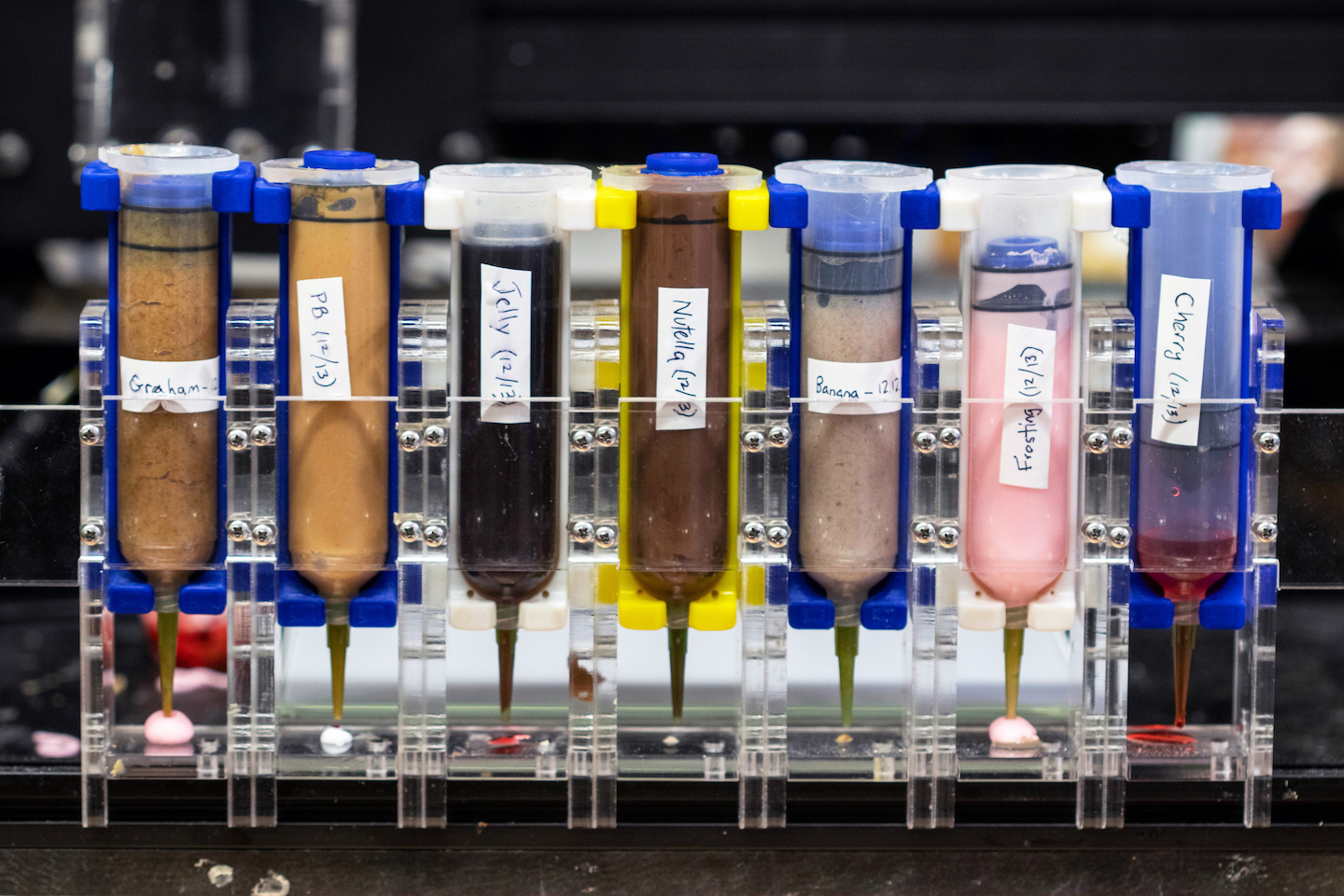
Appetizing or off-putting?
The 3-D printing robot chef can only assemble the ingredients it’s given and then add heat to cook the food. It cannot create foods from pure energy made from biowaste, like the fictional Star Wars replicator does. But people may not yet be comfortable eating even this relatively simple version of machine-made meals, Blutinger says.
Most people are comfortable with items like flour and peanut butter because we know where they come from. As science moves food away from the source, though, people could get grossed out. That 3-D printed cake might be easier for some to eat than 3-D printed meat, for instance. And people who did not grow up with 3-D printers in the kitchen might prefer food from the grocery store, Blutinger says.
“But pretty soon…kids will be growing up with these kinds of food robots in their kitchen,” he predicts. “Then that’s all they’re going to know.”
Macdonald agrees. “It’s just one of those things that people will have to come to terms with.”
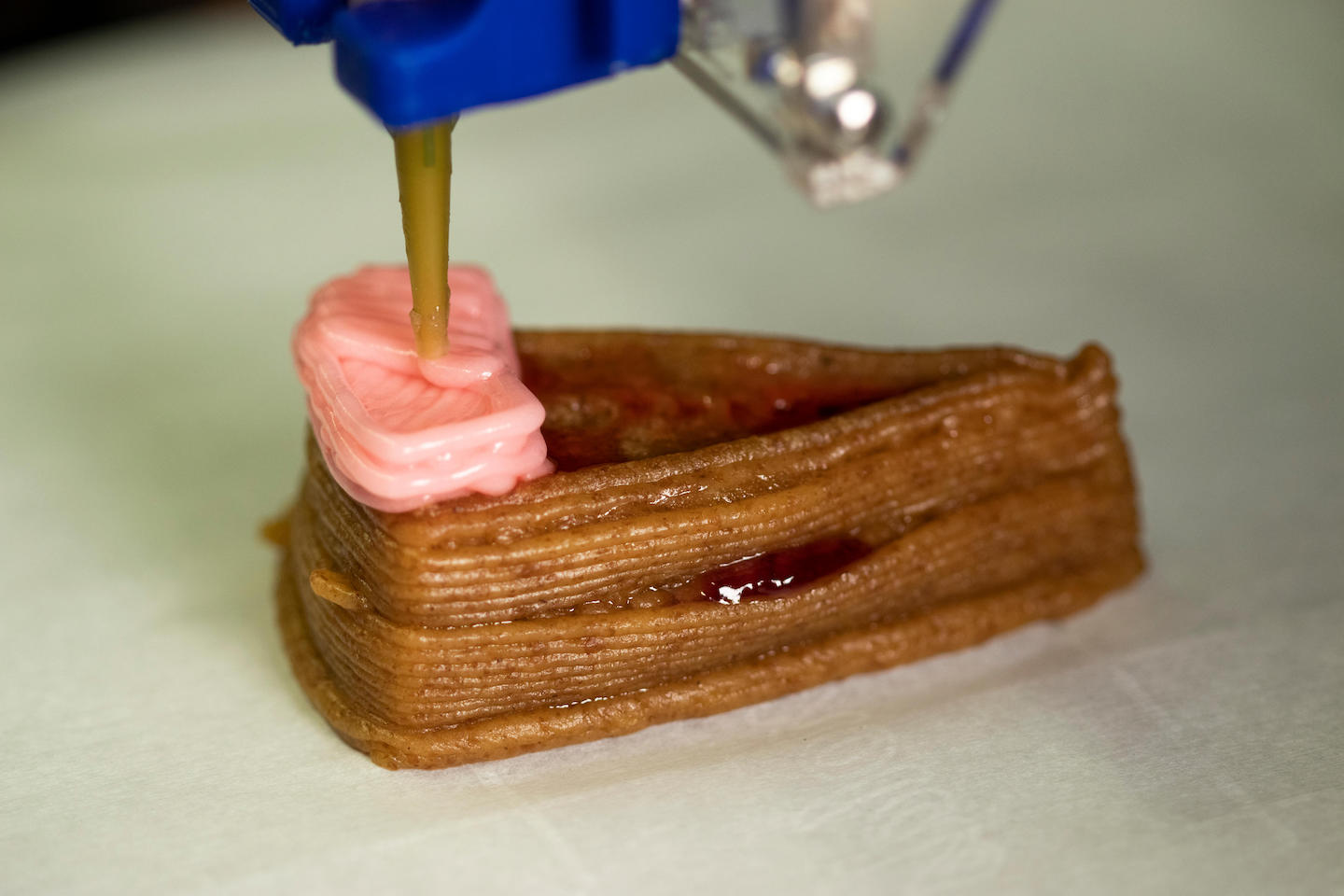
Food printers might be on our kitchen counters within the next 10 to 20 years, Sarri says. These printers could be like “having a personal chef and nutritionist all in one,” Blutinger adds. The machine could someday recommend and create healthier food that’s customized to your diet.
A Star Trek replicator might be possible, but not nearly as soon, says Sarri — maybe 100 years down the line. Those replicators of the future could be useful in areas in beyond outer space. They could provide food in places where putting a chef might be dangerous, such as a war zone.
“There’s a feedback loop,” Macdonald says, “of scientists being inspired by Star Trek and then making that science. And then that continues to feed into the science fiction of, ‘Well this is what we can do now, so what’s next?’”
The next tech to materialize might just be a replicator.
More Stories from Science News Explores on Tech

Bioelectronics research wins top award at 2024 Regeneron ISEF

Artificial intelligence is making it hard to tell truth from fiction
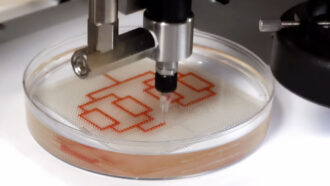
Lego bricks inspired a new way to shape devices for studying liquids
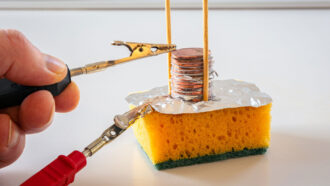

Experiment: Make your own cents-able battery
Scientists Say: Semiconductor

Here’s why AI like ChatGPT probably won’t reach humanlike understanding

Scientists Say: Digital Footprint

How to design artificial intelligence that acts nice — and only nice
Replicator (Star Trek)
In Star Trek a replicator is a machine that can create (and recycle ) things. Replicators were originally seen to simply synthesize meals on demand, but in later series much larger non-food items appear. The technical aspects of replicated versus "real" things is sometimes a plot element.
Origins and limitations
In the real world, external links.
Although previous sci-fi writers had speculated about the development of "replicating" or "duplicating" technology, [1] the term "replicator" was not itself used until Star Trek: The Next Generation . In simple terms, it was described as a 24th century advancement from the 23rd century "food synthesizer" seen in Star Trek: The Original Series . In Star Trek: The Original Series , food was created in various colored cubes. In Star Trek: The Animated Series (1974), various types of realistic-looking food could be requested, as in the episode entitled " The Practical Joker ". The mechanics of these devices were never clearly explained on that show. The subsequent prequel series, Star Trek: Enterprise , set in the 22nd century, featured a "protein resequencer" that could only replicate certain foods, so an actual chef served on board who used a hydroponic greenhouse where fruits and vegetables were grown. Additionally, that ship had a "bio-matter resequencer" which was used to recycle waste product into usable material. [2]
According to an academic thesis: "The so-called 'replicators' can reconstitute matter and produce everything that is needed out of pure energy, no matter whether food, medicaments, or spare parts are required." [3] A replicator can create any inanimate matter , as long as the desired molecular structure is on file , but it cannot create antimatter , dilithium , latinum, and (in the case of at least federation replicators) living things of any kind; for the last case, non-canon works such as the Star Trek: the Next Generation Technical Manual state that, though the replicators share the same technology with transporters , the resolution used is too low to create living tissue. However, other replicators, such as the ones used by the aliens in the TNG episode " Allegiance ", could create living things, including the brain's many trillions of dendritic connections where memory is stored.
One of the most important pieces of technology in the Star Trek universe, the replicator is used primarily to provide food and water on board starships , thus eliminating the need to stock most provisions (though starships, starbases, and other installations still stock some provisions for emergencies, such as in cases of replicator failure or an energy crisis.) On Star Trek: Deep Space Nine , it was established that as long as there is an energy source to power life support, replication is used to provide breathable air on ships and starbases (and to disassemble the carbon dioxide exhaled by the crew ), thus providing a seemingly endless supply of oxygen and eliminating the need to carry air tanks.
The technology is also used for producing spare parts , which makes it possible to repair most ship damage without having to return to a starbase. Other applications include replication of Starfleet uniforms and everyday objects such as toys and souvenirs. Replication is also used by the Holodeck program to allow food , clothes , and other objects belonging within a simulation to be used or consumed by the participants.
Starfleet 's safety protocols prevent unauthorized replication of dangerous objects, such as weapons and poisonous substances. [4]
Replicators can also convert matter into energy. Following that principle, the device can dismantle any object into subatomic particles. The ensuing energy can then be stored for future use or immediately applied in a subsequent replication. This process is referred to as "recycling", and is applied to everything from dirty dishes [5] to outgrown children's clothes.
Replicator technology, even if produced on a larger scale, had not been able to be used to create complex objects such as shuttlecraft or starships (the production staff felt that being able to replicate entire starships "at the push of a button" would severely impact dramatic potential). However, in the Star Trek: Deep Space Nine episode "For the Cause" , industrial replicators are used to replicate large components of ships, shuttlecraft , and other pieces of this sort, which are later used in shipyards to construct such vessels. In this manner, as few as 15 industrial replicators are enough to replicate the components needed to build a fleet of starships or to help a civilization recover from a planet-wide natural disaster.
This ability to reproduce complex machines is furthered during the first season of Star Trek: Prodigy . A replicator is shown to have the capacity to replicate an entire starship in the second episode, "Lost & Found", when Gwyn is attempting to escape the Protostar. When she reaches the shuttle bay, she finds a replicator with the technology to manufacture a complete ship. The process by which it is replicated takes minutes rather than seconds though, and behaves more similarly to a 3D printer than a traditional replicator. [6]
By virtually eliminating material scarcity, replicator technology plays an important role in the moneyless human economy within the Star Trek universe.
When the USS Voyager was pulled to the Delta Quadrant , it became clear that replicator technology was unknown to some of the indigenous peoples of that region. Throughout the first seasons, the Kazon and other races tried repeatedly to obtain the technology.
In the Voyager episode " State of Flux ", how the Kazon aliens obtain the technology from the USS Voyager, is a major plot point in the episode. [7]
Captain Janeway feared that if this technology were acquired by a civilization before they were ready, disastrous consequences could ensue. For this reason, and because of the Prime Directive , Janeway refused to give away the technology at any price.
Also on Voyager , the ship's energy constraints on the journey back to the Alpha Quadrant meant that replicator supplies had to be strictly controlled, leading to "replicator rations" becoming an unofficial ship currency. This is also the reason Neelix (aside from providing the crew with a morale boost through the preparation of fresh food) became employed as the ship's chef. Some ingredients came from the ship's hydroponics laboratory.
In 2014, researchers at Nestlé were reported as working on technology comparable to the replicator, with the goal of providing food tailored to an individual's nutritional requirements. [8]
Imperial College London physicists have discovered how to create matter from light — a feat thought impossible when the idea was first hypothesized in the 1930s. In just one day in Imperial's Blackett Physics Laboratory, three physicists worked out a relatively simple way to physically prove a theory first devised by scientists Breit and Wheeler in 1934. [9]
BeeHex, an Ohio startup company, received a grant in 2013 from NASA intended for developing long-spaceflight food 3D printing technology. They now build food printing robots for eventual public use. [10]
Cemvita Factory Inc., a biotech startup based in Houston, TX, is also developing a photobioreactor that converts carbon dioxide that's captured from air along with hydrogen from hydrolyzing water to nutrients and pharmaceutics. [11] [12] [13]
A 2016 article in The New Yorker noted that replicators may be a "metaphor for the distant endpoint of the Industrial Revolution". [14] They point out that technology as presented in Star Trek: The Next Generation changes the moral equation of being human, because nearly anything you want can be created with a request. [14]
They note that Captain Picard's favorite beverage, Earl Grey tea , is created by the replicator, and the character often states "Tea, Earl Grey, Hot" during the television show. [14] The beverage is then seen being produced in the replicator with a special visual and sound effect. [14]
- Molecular assembler
- Santa Claus machine
- Forever Peace , a 1997 novel by Joe Haldeman that features a similar device called the Nanoforge
- Cloudy with a Chance of Meatballs (film) , a 2009 film that features a similar device called the "Flint Lockwood Diatonic Super Mutating Dynamic Food Replicator"
- Station of Extreme Light
- Ai computer aided design (CAD)
Related Research Articles

Kathryn Janeway is a fictional character in the Star Trek franchise. She was the main character of the television series Star Trek: Voyager , which aired between 1995 and 2001. She served as the captain of the Starfleet starship USS Voyager while it was lost in the Delta Quadrant on the other side of the galaxy. After returning home to the Alpha Quadrant, she is promoted to vice admiral and briefly appears in the 2002 film Star Trek: Nemesis . She is seen again commanding the USS Dauntless in Star Trek: Prodigy , searching for the missing USS Protostar which was being commanded by Captain Chakotay, her former first officer on Voyager , at the time of its disappearance.

Chakotay is a fictional character who appears in each of the seven seasons of the American science fiction television series Star Trek: Voyager . Portrayed by Robert Beltran, he was First Officer aboard the Starfleet starship USS Voyager , and later promoted to Captain in command of the USS Protostar in Star Trek: Prodigy . The character was suggested at an early stage of the development of the series. He is the first Native American main character in the Star Trek franchise. This was a deliberate move by the producers of the series, who sought to provide an inspiration as with Uhura in Star Trek: The Original Series for African Americans. To develop the character, the producers sought the assistance of Jamake Highwater who falsely claimed to be Native American. Despite first being named as a Sioux, and later a Hopi, Chakotay was given no tribal affiliation at the start of the series, something that was later resolved in the episode "Tattoo".
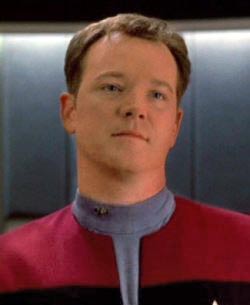
Lieutenant Thomas Eugene "Tom" Paris is a fictional character in the American science fiction television series Star Trek: Voyager and is portrayed by Robert Duncan McNeill. Paris is the chief helmsman, as well as a temporary auxiliary medic, of the USS Voyager , a Starfleet ship that was stranded in the Delta Quadrant by an alien entity known as the Caretaker.
Star Trek: Voyager is an American science fiction television series created by Rick Berman, Michael Piller and Jeri Taylor. It originally aired from January 16, 1995, to May 23, 2001, on UPN, with 172 episodes over seven seasons. It is the fifth series in the Star Trek franchise. Set in the 24th century, when Earth is part of a United Federation of Planets, it follows the adventures of the Starfleet vessel USS Voyager as it attempts to return home to the Alpha Quadrant after being stranded in the Delta Quadrant on the far side of the Milky Way galaxy.
In the Star Trek fictional universe, shields refer to a 23rd and 24th century technology that provides starships, space stations, and entire planets with limited protection against damage. They are sometimes referred to as deflectors , deflector shields , or screens . Types of shields include navigational deflectors .
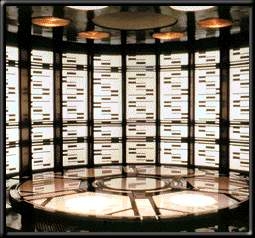
A transporter is a fictional teleportation machine used in the Star Trek science fiction franchise. Transporters allow for teleportation by converting a person or object into an energy pattern, then sending ("beaming") it to a target location or else returning it to the transporter, where it is reconverted into matter ("rematerialization").
The Star Trek fictional universe contains a variety of weapons, ranging from missiles to melee. The Star Trek franchise consists mainly of several multi-season television shows and a dozen movies, as well as various video games and inspired merchandise. Many aspects of the Star Trek universe impact modern popular culture, especially its fictitious terminology and the concept of weaponry on spacecraft. The franchise has had a widespread influence on its audiences from the late 20th to early 21st century. Notably, Star Trek 's science fiction concepts have been studied by real scientists; NASA described it in relation to the real world as "entertaining combination of real science, imaginary science gathered from lots of earlier stories, and stuff the writers make up week-by-week to give each new episode novelty." For example, NASA noted that the Star Trek "phasers" were a fictional extrapolation of real-life lasers, and compared them to real-life microwave based weapons that have a stunning effect.

USS Voyager (NCC-74656) is the fictional Intrepid -class starship which is the primary setting of the science fiction television series Star Trek: Voyager . It is commanded by Captain Kathryn Janeway. Voyager was designed by Star Trek: Voyager production designer Richard D. James and illustrator Rick Sternbach. Most of the ship's on-screen appearances are computer-generated imagery (CGI), although models were also sometimes used. The ship's motto, as engraved on its dedication plaque, is a quote from the poem "Locksley Hall" by Alfred, Lord Tennyson: "For I dipt in to the future, far as human eye could see; Saw the vision of the world, and all the wonder that would be."

Tuvok is a fictional character in the Star Trek media franchise and a main character in the television series Star Trek: Voyager . Tuvok is a Vulcan who serves as the ship's second officer, Chief of Security, and Chief Tactical Officer. He was portrayed by Tim Russ throughout the show's run from 1995 to 2001, as well as in subsequent portrayals.

The Holodeck is a fictional device from the television franchise Star Trek which uses "holograms" to create a realistic 3D simulation of a real or imaginary setting, in which participants can freely interact with the environment as well as objects and characters, and sometimes a predefined narrative.
" Caretaker " is the series premiere of the American science fiction television series Star Trek: Voyager . It was first broadcast as a double-length episode on January 16, 1995, as the first telecast of the fledgling UPN network. It was later split into two parts for syndication, but released in its original one-episode format on DVD and streaming services. Set in the 24th century, the series follows the adventures of the Starfleet and Maquis crew of the starship USS Voyager after they are stranded in the Delta Quadrant far from the rest of the Federation.
" State of Flux " is the eleventh episode of Star Trek: Voyager , which was a science fiction television show that ran from 1995-2001. Recurring Voyager characters Seska and Lt. Carey star, along with the show's main cast, in an episode that sees the return of the Kazon aliens previously introduced in "Caretaker".
" Relativity " is the 118th episode of the American science fiction television series Star Trek: Voyager airing on the UPN network. It is the 24th episode of the fifth season.
" Non Sequitur " is the 21st episode of Star Trek: Voyager , the fifth episode in the second season. Harry Kim is enigmatically stranded back on Earth, only to discover the lives of his companions have been radically altered. Much of the episode takes place on Earth in the same era as Voyager , but in alternate timeline caused by an anomaly.
" Shattered " is the 157th episode of the American science fiction television series Star Trek: Voyager , aired on the UPN network. It is the 10th episode of the seventh season.
" Maneuvers " is the 27th episode of Star Trek: Voyager , and the 11th episode in the second season. In this science fiction television show, the spacecraft USS Voyager encounters the Kazon and former crew member that defected, Seska. The episode features many scenes with Chakotay, Seska, and various guest stars in the role of the Kazon. It also features several special effect sequences with various spacecraft.
" Alliances " is the 30th episode of American science fiction television series Star Trek: Voyager airing on the UPN network, the 14th episode in the second season.
" Night " is the 95th episode of the American science fiction television series Star Trek: Voyager , the first episode of the fifth season.
String Theory: Cohesion is a 2005 novel by American author Jeffrey Lang, the first book of the Star Trek: Voyager series, a sci-fi series set in the Star Trek universe. It was released to commemorate the 10th anniversary of the television series Star Trek: Voyager and takes place between the 4th and 5th seasons.
- ↑ Star Trek: Enterprise : " Breaking the Ice "
- ↑ Mieke Schüller (2 October 2005). Star Trek - The Americanization of Space . GRIN Verlag. p. 5. ISBN 978-3-638-42309-0 .
- ↑ " Death Wish ". Voyager Season 2. No. 18. UPN . February 19, 1996
- ↑ Star Trek: Deep Space Nine, episode Hard Time .
- ↑ "Star Trek: Prodigy Gives Starfleet a Major Upgrade" . 4 November 2021.
- ↑ "Star Trek: Voyager's Must-Watch Episodes" . io9 . 28 April 2020 . Retrieved 2021-02-13 .
- ↑ "Nestle plans to create 'Star Trek-like food replicator' " . BBC. 24 June 2014.
- ↑ "Scientists discover how to turn light into matter after 80-year quest" .
- ↑ "NASA-Funded 3D Pizza Printer Now Works at Tourist Attractions" . 11 August 2016.
- ↑ "Deep Technology Based on Cognitive Chemistry" . www.cemvitafactory.com . Retrieved March 4, 2019 .
- ↑ Archived at Ghostarchive and the Wayback Machine : "Cemvita Factory NASA iTech - Moji Karimi" (video) . CemVita Factory Inc. September 1, 2018 . Retrieved March 4, 2019 .
- ↑ Tonar, Ellis Talton and Remington. "Space Tech Startups Are The Key To Making Life On Mars Possible" . Forbes . Retrieved March 4, 2019 .
- 1 2 3 4 Saadia, Manu (2016-09-08). "The Enduring Lessons of "Star Trek" " . The New Yorker . ISSN 0028-792X . Retrieved 2019-07-24 .
- Replicator at Memory Alpha
- "Transporters, Replicators and Phasing FAQ" by Joshua Bell
- List of staff
- Gene Roddenberry
- Norway Corporation
- musical theme
- " Where no man has gone before "
- " Beam me up, Scotty "
- Accolades (film franchise)
- The God Thing
- Planet of the Titans
- Star Trek 4
- Reference books
- A Klingon Christmas Carol
- Klingon opera
- The Ready Room
- How William Shatner Changed the World
- Beyond the Final Frontier
- The Captains
- Trek Nation
- For the Love of Spock
- What We Left Behind
- Kirk and Uhura's kiss
- Comparison to Star Wars
- productions
- Memory Alpha
- Shakespeare and Star Trek
- The Exhibition
- The Experience
- " The Last Voyage of the Starship Enterprise " (1976 SNL sketch)
- Free Enterprise (1999 film)
- Galaxy Quest (1999 film)
- " Where No Fan Has Gone Before " (2002 Futurama episode)
- The Orville (2017 television series)
- Please Stand By (2017 film)
- " USS Callister " (2017 Black Mirror episode)
The Replicator: Maybe You Can Have Everything
- First Online: 25 August 2016
Cite this chapter

- Mark E. Lasbury 2
743 Accesses
Star Trek represents a post-scarcity society in which all material needs are met through the use of the replicator. Raw materials at the atomic level are manipulated in a bottom-up manner to build whatever object is needed, in real time. This may seem like science fiction, but research is bringing manufacture on a molecular scale closer every day. 3D printing has developed to the point that simple objects can be made at home for only a few dollars, but the technologies have moved well beyond 3D printing of plastics or metal. 4D techniques that allow for products that respond to environmental changes are moving into the marketplace, as are printed foods and biological tissues and organs. Beyond these technologies lies true molecular manufacturing wherein nanotools or nanobots produce themselves and manipulate raw materials in order to build products one atom at a time. Already there are wrenches, motors, and light-powered submarines being produced that consist of only a few atoms, but are powerful enough do work on small molecules or individual atoms.
The replicators on decks four through nine are producing nothing but cat food. —Commander Riker TNG: A Fistful of Datas
This is a preview of subscription content, log in via an institution to check access.
Access this chapter
- Available as EPUB and PDF
- Read on any device
- Instant download
- Own it forever
- Compact, lightweight edition
- Dispatched in 3 to 5 business days
- Free shipping worldwide - see info
Tax calculation will be finalised at checkout
Purchases are for personal use only
Institutional subscriptions
SE Bakarich, R Gorkin, M in het Panhuis, and GM Spinks. 4D Printing with Mechanically Robust, Thermally Actuating Hydrogels. Macromolecular Rapid Communications 36(12); 1211-1217, 2015. doi: 10.1002/marc.201500079 . http://www.sciencedaily.com/releases/2015/04/150423213500.htm
LE Bertassoni, M Cecconi, V Manoharan, J Hjortnaes, AL Cristino, G Barabaschi, D Demarchi, MR Dokmeci, Y Yang, and A Khademhosseini. Hydrogel bioprinted microchannel networks for vascularization of tissue engineering constructs. Lab Chip 14(13): 2202-2211, 2014. doi: 10.1039/c4Ic00030g . http://pubs.rsc.org/en/Content/ArticleLanding/2014/LC/C4LC00030G#!divAbstract
L Bindi, P Steinhardt, N Yao, and P Lu. Natural quasicrystals. Science 324(5932): 1306-1309, 2009. doi: 10.1126/science.1170827 . http://science.sciencemag.org/content/324/5932/1306.abstract
L Bindi, N Yao, C Lin, LS Hollister, CL Andronicos, VV Distler, MP Eddy, A Kosin, V Kryachko, GJ MacPherson, WM Steinhardt, M Yudoskaya, and PJ Steinhardt. Natural quasicrystal with decagonal symmetry. Scientific Reports 5; 9111, 2015. doi: 10.1038/srep09111 . http://www.nature.com/articles/srep09111
M Bobnar, P Jeglic, M Klanjsek, Z Jaglicic, M Wencka, P Popcevic, J Ivkov, D Stanic, A Smontara, P Gille, and J Dolinsek. Intrinsic anisotropic magnetic, electrical, and thermal transport porperties of d -Al-Co-Ni decagonal quasicrystals. Physcial Review B 85(2); 024205, 2012. doi: 10.1103/PhysRevB.85.02.024205 . http://journals.aps.org/prb/abstract/10.1103/PhysRevB.85.024205
WR Browne, and BL Feringa. Making molecular machines work. Nature Nanotechnology 1; 25-35, 2006. doi: 10.1038/nnano.2006.45 . http://www.nature.com/nnano/journal/v1/n1/full/nnano.2006.45.html
O Custance, R Perez, and S Morita. Atomic force microscopy as a tool for atom manipulation. Nature Nanotechnology 4; 803-810, 2009. doi: 10.1038/nnano.2009.347 . http://www.nature.com/nnano/journal/v4/n12/abs/nnano.2009.347.html
M Fessenden. 3-D printed windpipe gives infant breath of life. Scientific American Online. May 24, 2013. Accessed 09/12/15. http://www.scientificamerican.com/article/3-d-printed-windpipe/
R Feynman. There’s plenty of room at the bottom. Caltech Engineering and Science 23(5): 22-36, 1960. http://www.zyvex.com/nanotech/feynman.html
JE Fischer. Storing energy in carbon nanotubes. Chemical Innovation 30(10); 21-27, 2000. http://pubs.acs.org/subscribe/archive/ci/30/i10/html/10fischer.html
TC Fitzgibbons, M Guthrie, E Xu, VH Crespi, SK Davidowski, GD Cody, N Alem, and JV Badding. Benzene-derived carbon nanothreads. Nature Materials 14; 43-47, 2015. doi: 10.1038/nmat4088 . http://www.nature.com/nmat/journal/v14/n1/full/nmat4088.html
T Frey. The coming food printer revolution. FuturistSpeaker Blog, October, 17 2011. Accessed November 20, 2015. http://www.futuristspeaker.com/2011/10/the-coming-food-printer-revolution/
V García-López, PT Chiang, F Chen, G Ruan, AA Martí, AB Kolomeisky, G Wang, and JM Tour. Unimolecular Submersible Nanomachines. Synthesis, Actuation, and Monitoring. Nano Letters . November 5, 2015. Epub ahead of print doi: 10.1021/acs.nanolett.5b03764 . http://pubs.acs.org/doi/abs/10.1021/acs.nanolett.5b03764
Q Ge, HJ Qi, and ML Dunn. Active Materials by four-dimension printing. Applied Physics Letters 103; 131901, 2013. doi: 10.1063/1.4819837 . http://scitation.aip.org/content/aip/journal/apl/103/13/10.1063/1.4819837
TJ Hinton, Q Jallerat, RN Palchesko, JH Park, MS Grodzicki, HJ Shie, MH Ramadan, AR Hudson, and AW Feinberg. Three-dimensional printing of complex biological structures by freeform reversible embedding of suspended hydrogels. Sci Adv 1(9); e1500758, 2015. doi: 10.1126/sciadv.1500758 . http://advances.sciencemag.org/content/1/9/e1500758
Z Izadifar, T Chang, AM Kulyk, D Chen, and BF Eames. Analyzing biologicalperformance of 3D-printed, cell-impregnated hybrid constructs for cartilage tissue engineering. Tissue Eng Part C Methods Nov. 23, 2015 (Epub ahead of print) doi: 10.1089/ten.TEC.2015.0307 . http://online.liebertpub.com/doi/abs/10.1089/ten.TEC.2015.0307
S Jesse, Q He, AR Lupini, DN Leonard, MP Oxley, O Ovchinnikov, RR Unocic, A Tselev, M Fuentes-Cabrera, BG Sumpter, SJ Pennycook, SV Kalinin, and AY Borisevich. Atomic-Level Sculpting of Crystalline Oxides: Toward Bulk Nanofabrication with Single Atomic Plane Precision. Small 11(44); 5895-5900, 2015. doi: 10.1002/smll.201502048 . http://onlinelibrary.wiley.com/doi/10.1002/smll.201502048/abstract
H-W Kang, SJ Lee, IK Ko, C Kengla, JJ Yoo, and A Atala. A 3D bioprinting system to produce human-scale tissue constructs with structural integrity. Nature Biotechnology Published online February 15, 2016. doi: 10.1038/nbt.3413 . http://www.nature.com/nbt/journal/vaop/ncurrent/full/nbt.3413.html
S Kawai, AS Foster, FF Canova, H Onodera, S Kitamura, and E Meyer. Atom manipulation on an insulating surface at room temperature. Nature Communications 5; 4403, 2014. doi: 10.1038/ncomms5403 . http://www.nature.com/ncomms/2014/140715/ncomms5403/full/ncomms5403.html
DB Kolesky, RL Truby, AS Gladman, TA Busbee, KA Homan, and JA Lewis. 3D bioprinting of vascularized, heterogeneous cell-laden tissue constructs. Adv Mater 26(19); 3124-3130, 2014. doi: 10.1002/adma.201305506 . http://onlinelibrary.wiley.com/doi/10.1002/adma.201305506/abstract;jsessionid=569053B40DB17B11847A93900790129D.f02t03
A Koptyug, LE Rannar, M Backstrom, and R Langlet. Bulk metallic glass manufacturing using electron beam melting. In: Proceedings from Additive Manufacturing & 3D Printing , Nottingham, UK, July 2013, Nottingham, UK, 2013.
Google Scholar
T Kudernac, N Ruangsupapichat, M Parschau, B Maciá, N Katsonis, SR Harutyunyan, KH Ernst, and BL Feringa. Electrically driven directional motion of a four-wheeled molecule on a metal surface. Nature 479 (7372); 208, 2011. doi: 10.1038/nature10587 . http://www.nature.com/nature/journal/v479/n7372/full/nature10587.html
M Liu, VI Artyukhov, H Lee, F Xu, and BI Yakobson. Carbyne From First Principles: Chain of C atoms, a Nanorod or a Nanorope. ACS Nano 7(11); 10075 – 10082, 2013. doi: 10.1021/nn404177r . http://pubs.acs.org/doi/abs/10.1021/nn404177r
X Liu, ZJ Weinert, M Sharafi, C Liao, J Li, and ST Schneebeli. Regulating Molecular Recognition with C-Shaped Strips Attained by Chirality-Assisted Synthesis. Angewandte Chemie International Edition , 54(43); 12772-12776, 2015. doi: 10.1002/anie.201506793 . http://onlinelibrary.wiley.com/doi/10.1002/anie.201506793/abstract
ZP, Lu, CT Liu, JR Thompson, and WD Porter. Structural amorphous steels. Physical Review Letters 92; 245503, 2004. doi: 10.1103/PhysRevLett.92.245503 . http://journals.aps.org/prl/abstract/10.1103/PhysRevLett.92.245503
JF Morin, Y Shiarai, and JM Tour. En route to a motorized nanocar. Org Lett . 8(8); 1713-6, 2006. doi: 10.1021/ol060445d . http://pubs.acs.org/doi/abs/10.1021/ol060445d
D Oberhaus. Quasicrystals are nature’s impossible matter. Motherboard May 3, 2015. Accessed 11/04/15. http://motherboard.vice.com/read/quasicrystals-are-natures-impossible-matter
J Paek, I Cho, and J Kim. Microrobotic tentacles with spiral bending capability based on shape-engineered elastomeric microtubes. Scientific Reports , 5; 10768, 2015. doi: 10.1038/srep10768 . http://www.nature.com/articles/srep10768
K Pearson. Voice recognition search engine connected to 3D printer by Yahoo! Japan. MakerFlux, The Open Maker Community , September 19, 2013. Accessed 10/14/15. http://makerflux.com/voice-recognition-search-engine-connected-to-3d-printer-by-yahoo-japan/
Z Peng, J Lin, R Ye, ELG Samuel, and JM Tour. Flexible and stackable laser induced graphene supercapacitors. Applied Materials and Interfaces 7(5); 3414-3419, 2015a. doi: 10.1021/am509065d . http://pubs.acs.org/doi/abs/10.1021/am509065d
Z Peng, J Lin, R Ye, JA Mann, D Zakhidov, Y Li, PR Smalley, J Lin, and JM Tour. Flexible boron-doped laser-induced graphene microsupercapacitors. ACS Nano 9(6); 5868-5875, 2015b. http://pubs.acs.org/doi/abs/10.1021/acsnano.5b00436
M Schroeder. Fractals, Chaos, Power Laws: Minutes from an Infinite Paradise . New York: WH Freeman, 1991.
BH Shin, SM Felton, MT Tolley, and RJ Wood. Self-Assembling Sensors for Printable Machines. IEEE International Conference on Robotics and Automation (ICRA) , Hong Kong, China, May 31 – June 7, 2014. https://micro.seas.harvard.edu/papers/ICRA14_Shin.pdf
Y Shirai, AJ Osgood, Y Zhao, KF Kelly, and JM Tour. Directional control in thermally driven single-molecule nanocars. Nano Lett 5(11); 2330-4, 2005. doi: 10.1021/nl051915k . http://pubs.acs.org/doi/abs/10.1021/nl051915k
JA Stroscio, F Tavazza, JA Crain, RJ Celotta, and AM Chaka. Electronically induced atom motion in engineered CoCu nanostructures. Science 313 (5789); 948-951, 2006. doi: 10.1126/science.1129788 . http://science.sciencemag.org/content/313/5789/948
N Sugiyama, HY Xu, T Onoki, Y Hoshikawa, T Watanabe, N Matsushita, X Wang, FX Qin, M Fukuhara, M Tsukamoto, N Abe, Y Komizo, A Inoue, and M Yoshimura. Biocative titante nanomesh layer on Ti-based bulk metallic glass by hydrothermal-electrochemical technique. Acta Biomaterialia 5(4); 1367-1373, 2009. doi: 10.1016/j.actbio.2008.10.014 . http://europepmc.org/abstract/MED/19022712
I Williams, EC Oğuz, T Speck, P Bartlett, H Löwen, and CP Royall. Transmission of torque at the nanoscale. Nature Physics 12; 98-103, 2016. doi: 10.1038/nphys3490 . http://www.nature.com/nphys/journal/v12/n1/full/nphys3490.html
R Ye, Z Peng, T Wang, Y Xu, J Zhang, Y Li, LG Nilewski, J Lin, and JM Tour. In situ formation of metal oxide nanocrystals embedded in laser-induced graphene. ACS Nano 9(9); 9244-9251, 2015. doi: 10.1021/acsnano.5b04138 . http://pubs.acs.org/doi/abs/10.1021/acsnano.5b04138?journalCode=ancac3
L Zhang, X Wang, W Xu, Y Zhang, Q Li, PD Bradford, and Y Zhu. Strong and Conductive Dry Carbon Nanotube Films by Microcombing. Small , 11(31); 3830-3836, 2015. doi: 10.1002/smll.201500111 . http://onlinelibrary.wiley.com/doi/10.1002/smll.201500111/abstract
DA Zopf, SJ Hollister, ME Nelson, RG Ohye, and GE Green. Bioresorbable airway splint created with a three-dimensional printer. New Engl J Med 368; 2043-2045, 2013. doi: 10.1056/NEJMx1206319 . http://www.nejm.org/doi/full/10.1056/NEJMc1206319
Online Material
Made In Space Press Release, August 10, 2015. http://www.madeinspace.us/made-in-space-announces-in-vacuum-additive-manufacturing-breakthrough/
NASA Press release, November, 25, 2014. https://www.nasa.gov/content/open-for-business-3-d-printer-creates-first-object-in-space-on-international-space-station
NASA Press release, August 27, 2015. http://www.nasa.gov/press/2013/august/nasa-tests-limits-of-3-d-printing-with-powerful-rocket-engine-check/#.Vl0NWWSrSmM
Science Daily summary from ESA, June, 25, 2014. http://www.sciencedaily.com/releases/2014/06/140625133309.htm
Ray Kurzweils’ talk at Google I/O 2014. https://www.google.com/events/io/io14videos/4bdebcad-11da-e311-b297-00155d5066d7
Download references
Author information
Authors and affiliations.
Indianapolis, IN, USA
Mark E. Lasbury
You can also search for this author in PubMed Google Scholar
Corresponding author
Correspondence to Mark E. Lasbury .
Rights and permissions
Reprints and permissions
Copyright information
© 2017 Springer International Publishing Switzerland
About this chapter
Lasbury, M.E. (2017). The Replicator: Maybe You Can Have Everything. In: The Realization of Star Trek Technologies. Springer, Cham. https://doi.org/10.1007/978-3-319-40914-6_3
Download citation
DOI : https://doi.org/10.1007/978-3-319-40914-6_3
Published : 25 August 2016
Publisher Name : Springer, Cham
Print ISBN : 978-3-319-40912-2
Online ISBN : 978-3-319-40914-6
eBook Packages : History History (R0)
Share this chapter
Anyone you share the following link with will be able to read this content:
Sorry, a shareable link is not currently available for this article.
Provided by the Springer Nature SharedIt content-sharing initiative
- Publish with us
Policies and ethics
- Find a journal
- Track your research

Replicator ration
- View history
Replicator rations were an energy -conservation policy instituted on the USS Voyager , limiting the usage of the ship's replicators for each crewmember. The use of rationing for the replicator was a policy that was not consistently implemented; rather, it was done when the ship's available power supplies were limited. When Voyager was able to replenish its energy reserves, rationing was discontinued. It was never clearly stated how this policy was implemented or enforced.
Because some objects needed more energy to replicate than others, a replicator ration was not simply equal to one use of the replicator. Instead, a replicator ration was equal to a certain amount of energy used by the replicator for producing the requested object. For example a clarinet , a complicated object to replicate, required a week's worth of rations as opposed to one ration to use the replicator one time. ( VOY : " Parturition ") Tom Paris ' present for Kes , a locket, required two week's worth of rations. ( VOY : " Twisted ")
Shortly after the use of replicator rations was implemented on Voyager in 2371 , Captain Janeway attempted to use one of hers to replicate some coffee , but was dissuaded by Neelix , who advised her to set an example for the crew by using restraint. ( VOY : " The Cloud ")
One of ex- Maquis Kenneth Dalby 's infractions involved tampering with Voyager' s systems to give his friend extra rations. ( VOY : " Learning Curve ")
The next year , Lieutenant Paris started a gambling operation , wherein participants would attempt to guess the radiogenic particle count the following day at twelve hundred hours, using a pot of replicator rations. When Commander Chakotay found out about the game, he put a stop to it, stating that running a gambling ring was not appropriate behavior for a senior officer . ( VOY : " Meld ")
The year after that , after Paris and Harry Kim were released from the Akritirian maximum security detention facility , Paris suggested blowing a week's worth of replicator rations on the special meal they had fantasized about while in the prison. ( VOY : " The Chute ")
In 2376 , Paris pleaded with Neelix for replicator rations so he could replicate a 2342 Mouton Rothschild champagne , a Terellian pheasant , and a rose to celebrate his two-year anniversary with B'Elanna Torres . ( VOY : " Warhead ")
See also [ ]
- Ration card
External link [ ]
- Replicator ration at Memory Beta , the wiki for licensed Star Trek works
Smithsonian Voices
From the Smithsonian Museums

SMITHSONIAN BOOKS
The Influence of Star Trek and Science Fiction on Real Science
For Star Trek Day, learn about the relationship between sci-fi and real-life science in this excerpt from “Reality Ahead of Schedule”
:focal(800x602:801x603)/https://tf-cmsv2-smithsonianmag-media.s3.amazonaws.com/filer_public/b0/96/b096b98c-3581-4361-a150-3b7e655816b9/starship_enterprise.jpg)
As with several other iconic Star Trek technologies, replicators are directly responsible for inspiring developments in real-life technology, which use 3-D printing to create food, meals, plastic and metal items, buildings, and even complex machine parts. Star Trek is far from being the only sci-fi source of inspiration for the dream of a device that can produce finished items from scratch.
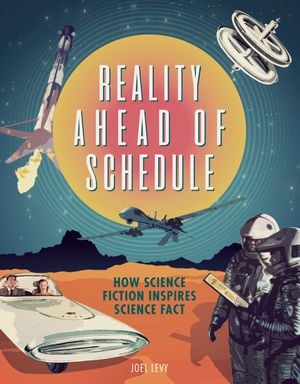
Reality Ahead of Schedule: How Science Fiction Inspires Science Fact
A rich visual history of science fiction's impact on real-world technologies, this book is perfect for lovers of H. G. Wells, Star Trek, Isaac Asimov, Jules Verne, Aldous Huxley, and 2001: A Space Odyssey.
To trace the roots of Star Trek ’s replicator, it is necessary to understand that it is essentially a repurposed form of the transporter—the teleportation or matter transmission device that “beams” the crew between starship and planet surface. According to legend, the transporter was invented only because the original series lacked the budget to film special, effect-heavy scenes of planetary landing shuttles, but Star Trek did not invent the concept of matter transmission. Its first appearance in science fiction dates back at least as far as 1877, in Edward Page Mitchell’s story “The Man Without a Body,” which prefigures George Langelaan’s much better-known 1957 story “The Fly,” by having a scientist experience a teleportation mishap when his batteries die while he is only partway through a transmission, so that only his head rematerializes. The replicator uses the same basic principle as the transporter, in which the atomic structure of a physical object is scanned and the information is used to reconstruct the object at the “receiving” end through energy-matter conversion. In practice, all transporters are replicators and matter “transmission” is a misnomer, because matter itself is not transmitted, only information. Every time Captain Kirk steps out of the transporter having “beamed up” from a planet’s surface, it is, in fact, a copy of him—the original has been disintegrated during the initial phase of the operation.
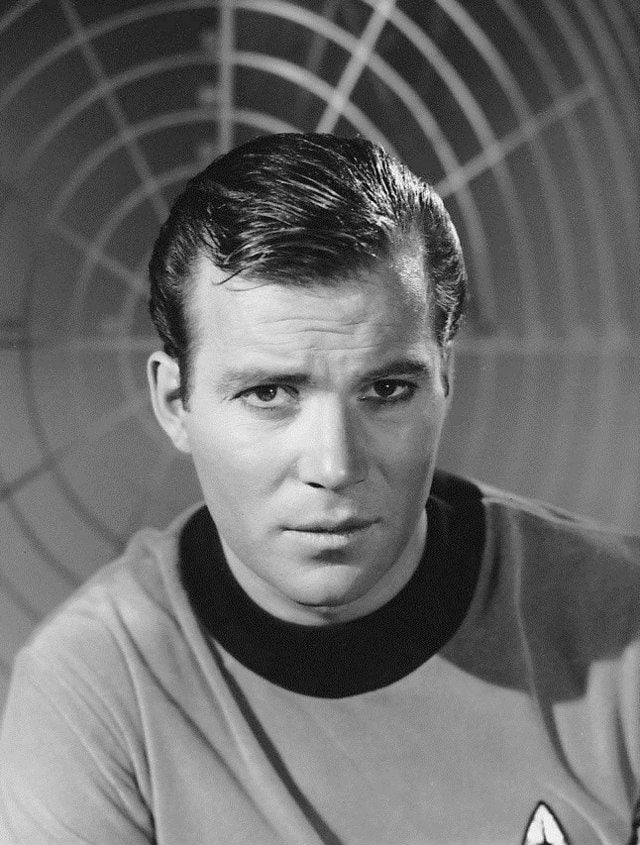
In the world of the TV series, the replicators of Picard’s Enterprise are a development of food synthesizers— simpler machines present on James Kirk’s Enterprise in the original Star Trek series (known as The Original Series , or TOS). These closely resemble the later replicators but were conceived by the writers of TOS more as highly advanced, mechanical food preparation devices instead of matter-energy converters. They, therefore, represented a televisual outing for a concept long popular in science fiction: the automatic food preparation device. A machine that performs complex autonomous physical tasks can reasonably be described as a robot, and, as early as 1899, Elizabeth Bellamy’s novel Ely’s Automatic Housemaid features a robot cook, which might be seen as a precursor to later food synthesizers. Unspecified “mechanical apparatus” was at work in the automated cafeterias of Edgar Rice Burroughs’s Mars. In his 1912 A Princess of Mars , Burroughs, probably inspired by the automat (a kind of vending machine café imported from Germany to the United States in 1902), describes “gorgeous eating places where we were served entirely by mechanical apparatus. No hand touched the food from the time it entered the building in its raw state until it emerged hot and delicious upon the tables before the guests, in response to the touching of tiny buttons to indicate their desires.”
Moving from Burroughs’s mechanical cafeterias to a Star Trek -style food synthesizer was simply a matter of miniaturization, and, by 1933, David H. Keller was imagining “a small but complete production laboratory, not much larger than [an] electric refrigerator … entirely automatic and practically foolproof.” In his story “Unto Us A Child Is Born,” Keller envisages a machine that can both create food and prepare it “for the table in any form desired by the consumer. All that was necessary was the selection of one of the twenty-five menus and the pressing of the proper buttons.” Only recently has this dream of a kitchen appliance-scale food synthesizer neared reality, with the launch of the Genie food replicator, explicitly inspired by Star Trek ’s replicator. The Genie, a device not much larger than a microwave with futuristic styling, claims to be “a kitchen in a box” that can make nutritious, freshly cooked meals in 30 seconds. However, it should be noted that the device relies on pods that contain dehydrated ingredients; in other words, the food preparation labor has simply been moved upstream in the process, and the Genie might be little more than a device for adding hot water to a cup of dried noodles.
/https://tf-cmsv2-smithsonianmag-media.s3.amazonaws.com/filer_public/97/87/9787a907-dd0b-4106-9b64-6e4c849f0ff8/3d_printer.jpg)
So what is meant by today’s technology boosters when they talk excitedly about Star Trek -inspired, real-life replicators? The technology to which they refer is the 3-D printer, a device that lays down some form of plastic (in the sense of malleable) medium in layers to build up a three-dimensional form. Such printers are heralded as the drivers of a second Industrial Revolution, in which manufacturing is distributed and universal, available to all through desktop 3-D printing machines. These devices are already available, usually restricted to fabrication using quick-setting plastics or resins, but larger and more specialized machines can print in media varying from living cells and foodstuffs to metal to mud or concrete. Large-scale concrete printers, for example, are suggested as a solution to housing crises, such as those found in refugee camps, where rapidly assembled, cheaply erected structures are needed. Meanwhile, biological implants and replacement tissues can be printed by laying down layers of cells on organic scaffolding, and, in the near future, it may be possible to print entire organs for transplant.
Although the 3-D printing community often plays up the lineage of inspiration from Star Trek ’s replicators to desktop fabricators, in practice, the former has a completely different mechanism. The true conceptual forefather of the 3-D printer is a 1964 story by Italian writer Primo Levi, “L’ordine a buon mercata” (“Order on the Cheap”). A mysterious multinational enterprise of dubious intentions makes available a device called the Mimer duplicator, which can create exact replicas of anything from money and diamonds to food and humans. It works by extruding “extremely thin superimposed layers” of a multielement substance named “pabulum.” This is a concise and extremely accurate description of how a modern-day 3-D printer works.
Star Trek featured gadgetry and devices that have since become iconic, and that have been directly responsible for inspiring the gadgetry and devices that have come to dominate modern personal technology—including the smartphone and the tablet computer—and perhaps soon to include portable, personal medical devices. Science and technology sometimes progresses in mighty leaps, but more generally it advances incrementally, contingent on prior research.
Reality Ahead of Schedule: How Science Fiction Inspires Science Fact is available from Smithsonian Books. Visit Smithsonian Books’ website to learn more about its publications and a full list of titles.
Excerpt from Reality Ahead of Schedule © 2019 by Carlton Books Limited

IMAGES
VIDEO
COMMENTS
On a side note, though, replicators are still great for vegans and vegetarians in this regard. The technology can replicate animal products without ethical issue, converting vegetation into ...
Of course, these programmed limitations can often be overridden by people of sufficient rank, as when only senior officers have access to certain dishes in Star Trek: Lower Decks. But replicators also have broader functional limitations, struggling to recreate certain complex items such as Borg cortical nodes or bio-neural gel packs, a ...
In Star Trek a replicator is a machine that can create (and recycle) things. Replicators were originally seen to simply synthesize meals on demand, but in later series much larger non-food items appear. The technical aspects of replicated versus "real" things is sometimes a plot element.
The ultimate recycling machine, replicators are the evolutionary successor of the protein resequencer technology seen in "Star Trek: Enterprise." Using transporter technology, they work by ...
The same could be true in Star Trek: the larger the replicator, the greater the power draw to the point of being beyond diminishing returns. Share. Improve this answer. Follow ... Theoretically, replicators don't have limitations on what they can create. The energy amount is what matters. So, the more complex a material is, the greater the ...
Replicators are essential machines in the "Star Trek" universe. This device can reproduce food, tools, and sometimes even random viruses. Depending on the writer's imagination, it can make almost anything. In times of need, the replicator is the only thing that can feed the crew. And being so far from Federation ports and basses, replicators ...
Of course, "Star Trek" technology requires limitations, otherwise a lot of dramatic tension would be broken. It's been implied many times over various Trek series that replicators require a lot of ...
Star Trek envisions the future of humanity to be one of incredible achievements made possible by evolved philosophies as well as technologies. This hopeful view of tomorrow is perhaps the reason so many have dreamed of inventing real-life versions of Star Trek tech -- from the transporter to the tricorder -- and the replicator is one of the most coveted.From a scientific perspective, aspects ...
In the TV franchise Star Trek, this is possible with a piece of technology known as a "replicator.". Getting to a future where this tech exists, though, might take a bit of imagination and invention. The Star Trek replicator is used to make all kinds of objects, from a hot cup of Earl Grey tea to spare parts for spaceships.
The limitations of replicators are rarely explored in the actual series, but the TNG Technical Manual had a few things to say about them. There are noticable differences as replicators can leave micro bits of errors, as well as Captain Picard had said that he found replicated caviar being inferior to the real thing.
Fig. 1 Star Trek Replicator. First the cup is replicated and then the tea inside it at the preferred temperature. ... what the physics limitations are for such a device to be possible are briefly ...
Replicator (Star Trek) In Star Trek a replicator is a machine that can create (and recycle) things. Replicators were originally seen to simply synthesize meals on demand, but in later series much larger non-food items appear. The technical aspects of replicated versus "real" things is sometimes a plot element.
A casual, constructive, and most importantly, welcoming place on the internet to talk about Star Trek Members Online ... Replicator Limitations . Is there any evidence that tells us in any detail what the limitations of replicators are? I rarely think about it, assuming that they replicate anything because they usually always do. However, in ...
Replicators in Star Trek begin as a way to make food (ENT: Fight or Flight) using proteins (for ENT) or organic molecules of an ill described nature (TOS, TNG, DS9, and VOY).This "protein resequencer" rearranges amino acids in proteins to produce other proteins (with some exceptions) for Captain Archer and his crew, while several decades later, Spock, Kirk and the Constitution class ...
The replicator might have groundbreaking implications, but it does have some inherent limitations as well: the objects it produces are small, and require special synthetic resin to produce. But it's an exciting new technology - and one that could lead to a Star Trek future.
A replicator, replicator system, replication system, or molecular synthesizer was a device that used matter-energy conversion technology similar to a transporter to produce almost anything from a ship's replicator reserves. (TNG: "Lonely Among Us", "Deja Q"; DS9: "Visionary"; VOY: "Virtuoso"; ENT: "Dead Stop") It was also capable of inverting its function, thus recycling the item. (DS9: "Hard ...
Replicator rations were an energy-conservation policy instituted on the USS Voyager, limiting the usage of the ship's replicators for each crewmember. The use of rationing for the replicator was a policy that was not consistently implemented; rather, it was done when the ship's available power supplies were limited. When Voyager was able to replenish its energy reserves, rationing was ...
Maybe, but in the universe of Star Trek which has stuff like warp drives, replicators, transporters, holodecks, telepathy, etc there are a lot bigger technical problems out there IMO. Maybe someone in Star Trek has invented a way to harness the energy of nuclear explosions and put it back in the replicator batteries lol.
So a replicator is just a follow-on to transporter technology. If this is an accurate description of Star Trek replicators, then a replicator can replicate itself as long as it has a digital pattern and a source of the right bulk material to work from. 1 Unfortunately, I have no chance of finding a reference for that now.
As with several other iconic Star Trek technologies, replicators are directly responsible for inspiring developments in real-life technology, which use 3-D printing to create food, meals, plastic ...